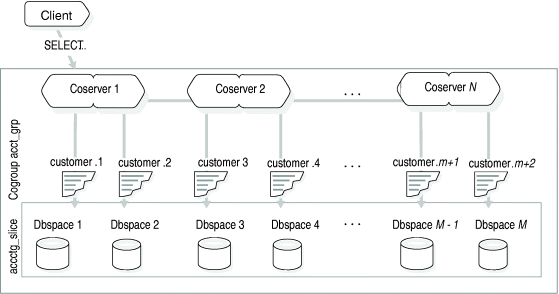
It is recommended that you partition VLDBs across many coservers in Extended Parallel Server. Each table fragment is stored in its own dbspace; therefore, you can create thousands of storage objects (fragments, dbspaces, chunks, and so on) spread across multiple coservers. Managing these individual storage objects can be complex and error-prone unless you can manage groups of them.
Extended Parallel Server uses a dbslice to manage many storage objects. A dbslice is a named set of dbspaces that you can manage as a single storage object. A dbslice contains all of the traditional database server storage units: dbspaces, chunks, and so on.
A dbslice facilitates management of storage objects because you can refer to all of the storage objects for a single table with a single name, the dbslice name. For example, to fragment a table across 100 coservers, you can use the following CREATE TABLE statement to specify a single dbslice name instead of 100 dbspace names:
CREATE TABLE customer
(cust_id integer,
...
)
BY HASH (cust_id)
IN customer_dbslc;
In this example, the SQL operation takes place for all of the underlying dbspaces in the customer_dbslc dbslice.
To define a dbslice, use the onutil CREATE DBSLICE command. The onutil command-line utility accepts commands that create, alter, and drop storage objects (dbslices and cogroups).
When you create a dbslice, you specify the cogroup name so that Extended Parallel Server knows the coservers on which to create dbspaces. For example, you might create a dbslice from an accounting cogroup. The following partial commands show how to create a cogroup and dbslice:
% onutil 1> create cogroup acctg_group 2> . 3> . 4> . 5> create dbslice acctg_dbslc 6> FROM acctg_group . . .
You do not need to specify the names explicitly for all of the individual dbspaces that are associated with the partitioned tables. Extended Parallel Server generates the dbspace names for you.
For more details on the onutil CREATE COGROUP, onutil CREATE DBSLICE, and onutil alter dbslice commands, see the utilities chapter of the IBM Informix: Administrator's Reference. Figure 59 illustrates a cogroup and a dbslice.

A rootslice is a named set of root dbspaces that you can manage as a single storage object. Extended Parallel Server creates a root dbspace on each coserver. To facilitate management of multiple root dbspaces, Extended Parallel Server provides rootslices.
A temporary dbslice is a named set of temporary dbspaces that reside on multiple coservers. You can manage temporary dbspaces as a single storage object by using the dbslice name.
For information on how to create a temporary dbslice, refer to the TEMP keyword in the onutil CREATE DBSLICE command in the IBM Informix: Administrator's Reference.
Home | [ Top of Page | Previous Page | Next Page | Contents | Index ]